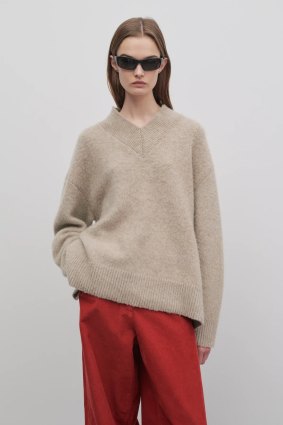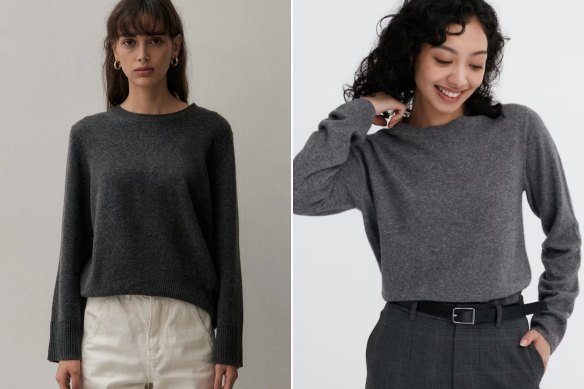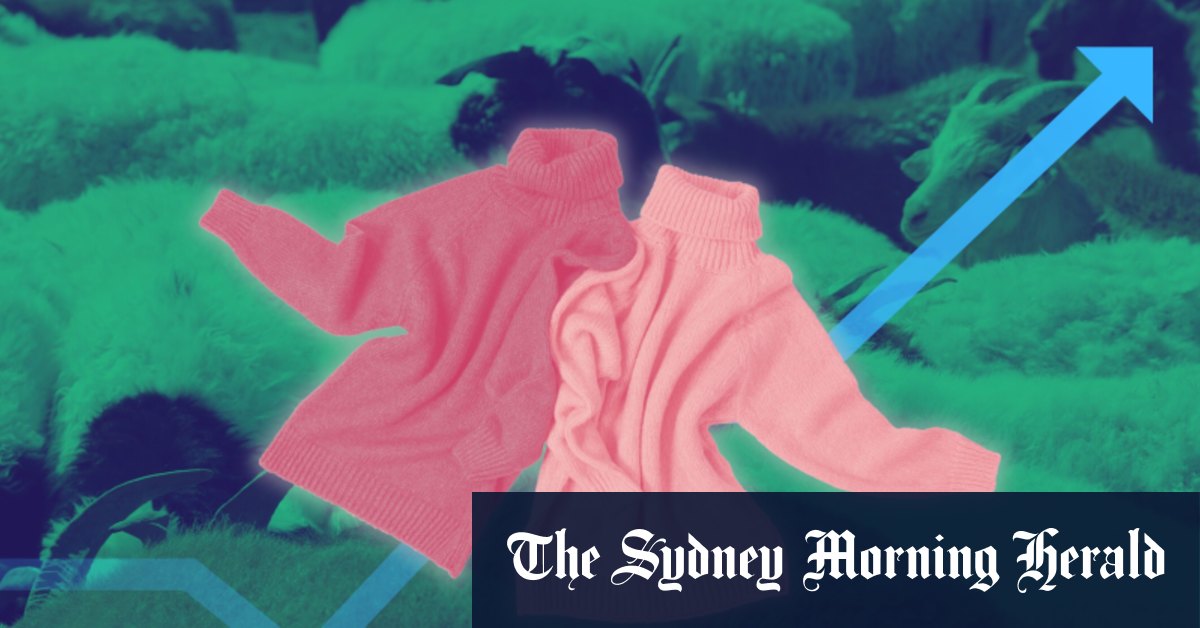“It used to be this wonderful, rare luxury fibre that you would save up for, keep for a lifetime and then maybe pass down through generations,” she says. “I think cashmere has become a sort of case study for how fashion has lost its way and its soul and its connection to heritage and the beauty of luxury that used to inform it.”
Press says the incursion of luxury fibres like cashmere into the fast fashion market mask the actual labour that make them special in the first place.
“It’s ridiculous because you’re training the customer to believe that this should be super accessible and that everybody has a right to luxury without thinking about what the impacts are on the goat herders, the environment and the goats themselves.”
Sustainability advocate Clare Press says our shifting attitude to cashmere is emblematic of broader trends in the fashion industry.Credit: Rhett Wyman
How sustainable is cashmere?
According to Press, the framework to support our growing appetite for cashmere is simply not there. Between 1999 and 2019, the number of goat herds in Mongolia, the world’s second-largest exporter of cashmere, rose from seven million to 27 million.
With rising goat populations comes the risk of overgrazing, which contributes to the degradation of land and desertification. Unlike sheep, cashmere goats consume more (up to 10 per cent of their body weight) and eat a wider variety of plants, which they chew down to the root. And with falling cashmere prices globally, many herders choose to keep larger flocks than are sustainable as insurance against a volatile market. One report from 2018 found that grazing had degraded 58 per cent of Mongolia’s land as of 2016, 23 per cent of which was classified as heavily or fully degraded.
On top of this, the growing trade has been linked to the destruction of ecosystems that support endangered species like snow leopards.
Does price equal quality?
Not all cashmere is created equal says Amy Jones, the co-founder of Australian knitwear brand Mia Fratino. Typically, she explains, cashmere is extracted yearly manually, by combing the underbelly of the goat to extract the softest hairs of their winter coat.
Larger retailers, however, often pressure manufacturers with high-volume orders. To meet this demand (and push costs down), “goats are often shaved [rather than combed] throughout the year,” says Jones, leaving the animals exposed to the elements and living in cruel conditions.
These poor living conditions affect the health of the goat, and when combined with shaving rather than combing, result in a shorter, poorer quality fibre. These subpar fibres are what make up affordable cashmere products, which as Jones explains do not stand the test of time.

The Row “Fayette” cashmere jumper, $4360.
Unfortunately, Jones says it can be impossible to distinguish between high and low-quality cashmere when a garment is hanging on the rack. Issues will usually only present with time, as a cheaply made item will pill and degrade far more quickly. However, Jones notes that all cashmere, no matter the quality, will pill. Learning how to properly care for a garment, and investing in a quality de-piller, will prolong its lifespan.
But is there a ceiling to how much price impacts quality? How good can a $3000 sweater really be, compared to a $500 one? Not that much better, says Jones. “You’re paying for the brand name.”
Nor does a higher price always mean a more ethically produced garment. In April, an investigation from Bloomberg revealed that cashmere from luxury Italian label Loro Piana, whose pieces retail for upwards of $3000, was produced using free Peruvian labour.
It’s difficult to put a price on good cashmere, agrees Press. “If we lived in a logical world, I would be able to say: ‘Yes. If you pay X amount, you’re safe’.”
“Unfortunately, because brands are free to charge whatever they feel like for perceived value and the cachet of a luxury brand tag, that isn’t the case.”
Tips on caring for cashmere
- Minimise how often you wash your sweaters.
- Steam or hang your pieces out to air between washes to keep them fresh. Since cashmere is a natural fibre, odours and dirt don’t cling to them as much.
- Invest in a cashmere brush.
- Store garments with cedar balls if you have moth problems.
– Nicole Harlen, founder of The Curated
Jones, whose cashmere retails for around $350, says her brand operates on a “clean margin structure”. They have a fully vertical operation with their own factory, which enables transparent manufacturing processes and for reduced costs.
The Curated, a Scandinavian-based fashion label that aims to “sell luxe basics at affordable prices”, has a similar system – their cashmere pieces sell for what they say is a third of the retail price of equivalent brands. “I believe this is one of the advantages of being direct-to-consumer,” says the brand’s founder Nicola Harlen. “We’re also very lean on our margins – we don’t do big mark-ups or factor in discounts.”
Harlen wants to combat the perception that more expensive always equals better. “One of the problems that we have around talking about sustainability and fashion is that luxury brands have been falling under the radar for a long time, and we focus on fast fashion.
“But there are actually many luxury fashion garments, and I’m talking beyond cashmere but across the apparel category, that produce in the same factories as cheaper garments.”

A cashmere jumper from Scandinavian label The Curated (left) and from Uniqlo.
How to buy cashmere
Press’ first tip is to avoid buying new cashmere altogether. Instead, look for brands that use recycled cashmere, or shop second hand where high-quality pieces can be found for good prices. Press says she’s found some extraordinary cashmere pieces at op-shops, including a pristine jumper from Scottish brand Barrie, which retails new for almost $2000.
If you do want to buy new, there are a few things to look for. First, while higher prices aren’t necessarily an indicator of a better garment, lower ones are generally not a good sign.
Loading
“As a basic rule of thumb, I would say a red flag if you’re buying cashmere is if it’s very cheap,” says Press. “$100 is not enough for a garment to be produced sustainably.”
Secondly, do your research, and find a brand that works with a third-party accreditation. Press says The Good Cashmere Standard and the Oeko-Tex® Standard are both reputable metrics to go by.
A brand that is cagey about its supply chain is another red flag. Take some time to investigate where a brand sources its cashmere, and if you can’t find anything, don’t be afraid to ask.
Finally, if you do need to shop at a fast fashion retailer, Jones suggests opting for merino wool, which has a lighter environmental footprint but similar qualities to cashmere.
Ultimately, Press says the goal should always be to consume less.
“Do we really need to constantly update our wardrobes, to be constantly shopping? Maybe ask to borrow your dad’s sweater before hitting the mall.”
Make the most of your health, relationships, fitness and nutrition with our Live Well newsletter. Get it in your inbox every Monday.







